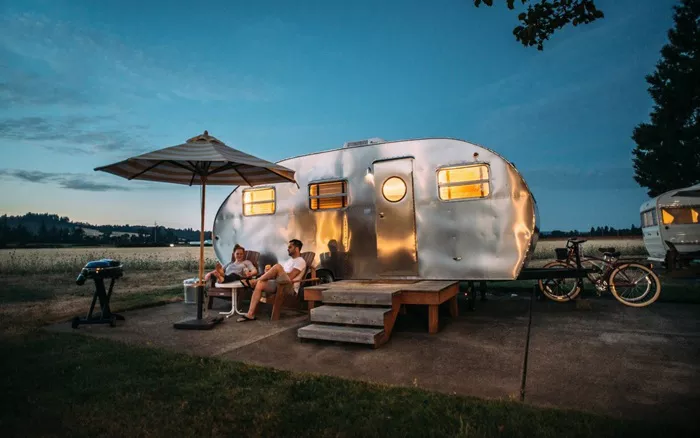Camping is a wonderful way to connect with nature and take a break from the daily grind. Whether you’re a seasoned camper or a beginner, knowing what to pack for a two-day camping trip can make all the difference. This guide will provide a detailed checklist of essentials to ensure you have a safe and enjoyable experience.
Planning Your Trip
Before packing, it’s crucial to plan your trip. Consider the following:
Destination: Where will you be camping? Research the area.
Weather: Check the weather forecast. Be prepared for rain or cold.
Activities: What will you do? Hiking, fishing, or relaxing by the fire?
SEE ALSO: Is It Safe to Sleep Outside Without a Tent?
Shelter and Sleeping Gear
Having a comfortable place to sleep is vital. Here’s what you’ll need:
Tent
Choose the Right Size: Make sure the tent can accommodate everyone. A two-person tent for two people or a four-person tent for a small family.
Check for Completeness: Ensure you have all parts, including poles and stakes.
Sleeping Bag
Temperature Rating: Choose a sleeping bag rated for the expected temperatures. A 3-season bag is usually a safe choice for spring or fall camping.
Sleeping Pad: A sleeping pad provides insulation and comfort. Look for lightweight and easy-to-pack options.
Pillow
Camping Pillow: Consider a small, inflatable camping pillow or a stuff sack filled with clothes.
Cooking and Food Supplies
Proper food preparation is essential for a great camping experience. Bring the following items:
Cooking Equipment
Camp Stove: A portable stove is ideal for cooking meals. Make sure to bring fuel.
Cookware: Include pots, pans, and a kettle. Non-stick options are easy to clean.
Utensils: Don’t forget spatulas, serving spoons, and a can opener.
Eating Supplies
Plates and Bowls: Bring reusable or disposable plates and bowls.
Cups and Cutlery: Include forks, knives, and spoons.
Food and Snacks
Meal Plan: Plan your meals for both days. Easy options include sandwiches, pasta, and canned foods.
Snacks: Pack trail mix, energy bars, and fruit for quick snacks.
Cooler and Ice Packs
Keep Food Fresh: A cooler can help keep perishables fresh. Use ice packs or frozen water bottles.
Clothing and Personal Items
Dress appropriately for the weather. Layering is key.
Clothing
Base Layer: Wear moisture-wicking shirts and thermal underwear.
Insulating Layer: Pack fleece or down jackets for warmth.
Outer Layer: A waterproof and windproof jacket is essential.
Pants: Quick-dry pants or shorts are ideal for outdoor activities.
Footwear
Hiking Boots: Sturdy, comfortable boots are crucial for hiking.
Camp Shoes: Consider sandals or slip-ons for around the campsite.
Accessories
Hats and Gloves: Pack a warm hat and gloves if it’s chilly.
Socks: Bring extra pairs of moisture-wicking socks.
Sunglasses and Sunscreen: Protect yourself from UV rays.
Toiletries
Basic Toiletries: Include toothbrush, toothpaste, biodegradable soap, and a quick-dry towel.
Toilet Paper: Always bring your own. Pack it out if necessary.
Safety and First Aid
Safety should always be a priority while camping.
First Aid Kit
Basic Supplies: Include band-aids, antiseptic wipes, pain relievers, and any personal medications.
Emergency Supplies: Consider including tweezers, scissors, and a thermometer.
Navigation Tools
Map and Compass: Know how to read a map. A compass can help with navigation.
GPS Device or Smartphone: Ensure your phone is charged and has offline maps.
Fire Safety
Firestarter: Bring waterproof matches, a lighter, or a fire starter kit.
Firewood: Check local regulations for collecting firewood. Pack some if allowed.
Lighting and Tools
Proper lighting and tools can enhance your camping experience.
Lighting
Lanterns: Battery-operated or solar lanterns provide ample light for your campsite.
Headlamps: A headlamp is hands-free and great for nighttime activities.
Multi-tool or Knife
Utility Knife: A good multi-tool or camping knife is essential for various tasks.
Rope or Paracord: Useful for securing gear or making a clothesline.
Recreation and Comfort
Make your camping experience enjoyable with some recreational items.
Outdoor Games
Pack Games: Bring cards, frisbees, or a small board game for evening fun.
Fishing Gear: If you plan to fish, bring your rod and tackle.
Comfort Items
Camping Chair: A lightweight chair can make relaxing around the campfire comfortable.
Blanket: A cozy blanket for chilly evenings can enhance comfort.
Trash and Cleanup
Leave no trace by packing out all your trash.
Trash Bags
Pack It In, Pack It Out: Bring garbage bags to collect all waste.
Recycling Bags: Separate recyclables if possible.
Cleaning Supplies
Biodegradable Soap: Use it for washing dishes and hands.
Sponge and Towel: Bring a sponge for cleaning and a towel for drying.
Final Checklist Before You Leave
Before heading out, do a final check to ensure you have everything:
- Tent and Sleeping Gear
- Cooking Equipment and Food
- Clothing and Personal Items
- Safety and First Aid Supplies
- Lighting and Tools
- Recreational Items
- Trash and Cleanup Supplies
Conclusion
A successful two-day camping trip requires careful planning and packing. By following this comprehensive guide, you’ll be well-prepared for your adventure. Enjoy the great outdoors, make memories, and don’t forget to take lots of pictures! Happy camping!
Related topics:
- The 8 Best Camping Lights 2024
- The 7 Best Camping Flashlights of 2024
- The 7 Best Camping Pads of 2024

